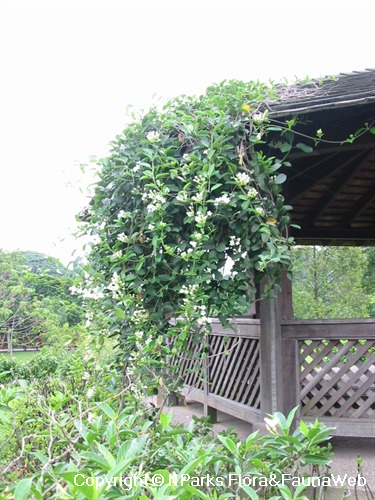
Back
Stephanotis floribunda Brongn.
| Family Name: | Apocynaceae |
| Common Name: | Madagascar Jasmine, Bridal Wreath, Chaplet Flower, Waxflower, Floradora, Creeping Tuberose, Stephanotis, 非洲茉莉, 夜来香 |
Name
Classifications and Characteristics
| Plant Growth Form | Climber |
|---|---|
| Lifespan (in Singapore) | Perennial |
| Mode of Nutrition | Autotrophic |
Biogeography
| Native Distribution | Madagascar |
|---|---|
| Native Habitat | Terrestrial |
| Preferred Climate Zone | Tropical |
| Local Conservation Status | Non-native |
Description and Ethnobotany
| Growth Form | It has a twining growth form and can grow up to 2 to 3m in height. |
|---|---|
| Foliage | It has coriaceous, dark green leaves with net venation which are arranged in pairs on the stem. Leaves are oblong to oblong-elliptical in shape with a minutely mucronate apex. |
| Flowers | The flowers are highly fragrant, white and borne on umbel-like cymes. |
| Fruit | The fruit is a fleshy follicle. |
| Cultivation | Ideally grown in well aerated, moisture retentive, organic-rich potting medium under full sun. |
| Etymology | The genus name 'Stephanotis' is derived from two words 'stephanos' crown and 'otos' ear, the later referring to the auricled staminal corona. |
| Ethnobotanical Uses | Cut - Dried Flower: The flowers of Stephanotis floribunda is often used for bridal bouquets. |
Landscaping Features
| Desirable Plant Features | Ornamental Flowers, Fragrant (Flowers), Ornamental Foliage |
|---|---|
| Landscape Uses | Suitable for Hanging Baskets, Trellis / Arbour / Pergola |
Fauna, Pollination and Dispersal
| Seed or Spore Dispersal | Abiotic |
|---|
Plant Care and Propagation
| Light Preference | Full Sun |
|---|---|
| Water Preference | Moderate Water |
| Rootzone Tolerance | Fertile Loamy Soils |
| Fertilizing | Fertilize fortnightly with dilute liquid feed whenever plant shows signs of growth. |
| Diseases | Can be infested with root mealybugs and scales. |
| Pest(s) | Sucking Insects |
| Propagation Method | Seed, Stem Cutting |
| Propagation Method Remarks | Taker stem cuttings with two to three nodes from non-flowering shoots. |
Foliar
| Foliage Retention | Evergreen |
|---|---|
| Mature Foliage Colour(s) | Green |
| Mature Foliage Texture(s) | Leathery |
| Foliar Type | Simple / Unifoliate |
| Foliar Arrangement Along Stem | Opposite |
| Foliar Attachment to Stem | Petiolate |
| Foliar Shape(s) | Non-Palm Foliage |
| Foliar Venation | Pinnate / Net |
| Foliar Margin | Entire |
| Foliar Apex - Tip | Mucronate |
Floral (Angiosperm)
| Flower Colour(s) | White |
|---|---|
| Flower Grouping | Cluster / Inflorescence |
| Flower Location | Axillary |
| Flower Symmetry | Radial |
| Inflorescence Type | Cyme |
Image Repository
Others
| Master ID | 208 |
|---|---|
| Species ID | 1504 |
| Flora Disclaimer | The information in this website has been compiled from reliable sources, such as reference works on medicinal plants. It is not a substitute for medical advice or treatment and NParks does not purport to provide any medical advice. Readers should always consult his/her physician before using or consuming a plant for medicinal purposes. |

